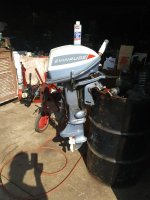You're in the process of doing the following from what I understand.
********************
(Magneto Armature Plate)
(J. Reeves)
If the armature plate has a a loose fitting, wobbling motion (the plate that the points, coils etc are attached to), it is usually caused by a slightly worn support ring. This allows the point setting to change erratically as the armature plate turns.
The cure is to remove the armature plate so that the support which is attached to the powerhead with 4 screws is visible. Then, with a screwdriver and hammer, or some tool of your choosing, and looking straight down at the support ring, make a slight indentation at what would be called the 12, 3, 6, and 9 O'clock positions. Install the armature plate and check for a smooth turning wobble free movement.
You may need to do that procedure a few times to obtain the proper fit (not too tight, not too loose), but it's worth the effort.
Use a small amount of anti corrosive grease between the aluminum ring and the brass support plate and also on the brass bushing of the armature plate when all is well.
********************
Also do the following.
********************
(Point Setting Of Magneto Models)
(J. Reeves)
Note that there are other ways to set points such as using a ohm meter or timing light... however, the following will result in a setting so close to being exact that one could not tell the difference.
Make sure that your feeler gauge is absolutely clean so as NOT to transfer oil/grease to the points.
Set the points as follows. Have the flywheel key aligned with the fiber rubbing portion of the ignition points. Adjust the gap so that a .020 gauge will pass thru but a .022 will not. Should there be any question of the points being dirty (touching the contact with your finger would cause them to be dirty), clean them with a small brush and acetone or lacquer thinner.
NOTE 1: Should the operating cam have a small portion on it with the word "SET" imprinted, align this portion with the fiber rubbing portion instead of the flywheel key.
NOTE 2: Should the cam have the word TOP embossed on the top of it, that is a cam that could be installed upside down and this is simply telling you which side is up. It is not a position where one would set the points.
********************
Unlikely you have a carburetor problem as carburetors do not come and go as you describe... if they're bad, they stay that way. However, since they can be adjusted improperly, do the following if you're not already doing so.
(Carburetor Adjustment - Single S/S Adjustable Needle Valve)
(J. Reeves)
Initial setting is: Slow speed = seat gently, then open 1-1/2 turns.
Start engine and set the rpms to where it just stays running. In segments of 1/8 turns, start to turn the S/S needle valve in. Wait a few seconds for the engine to respond. As you turn the valve in, the rpms will increase. Lower the rpms again to where the engine will just stay running.
Eventually you'll hit the point where the engine wants to die out or it will spit back (sounds like a mild backfire). At that point, back out the valve 1/4 turn. Within that 1/4 turn, you'll find the smoothest slow speed setting.
When you have finished the above adjustment, you will have no reason to move them again unless the carburetor fouls/gums up from sitting, in which case you would be required to remove, clean, and rebuild the carburetor anyway.


